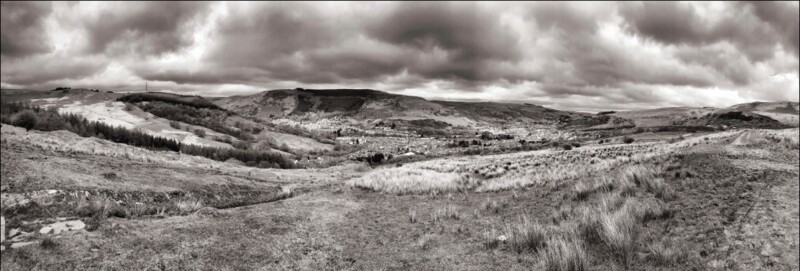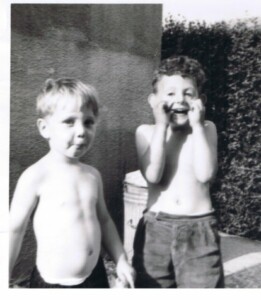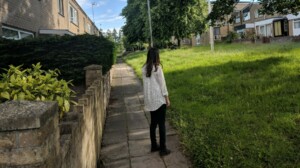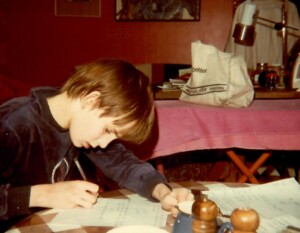Council Estate Memories: The Rhondda Valleys Brad Evans

Share this
If W B Yeats was right that it takes more courage to examine the dark corners of your soul than for any soldier to fight on the battlefield, what does it mean to examine our own childhoods when it comes to seriously thinking about violence?
We know about violence, we confront its appearance every day, we are continually forced to witness its occurrence, and yet most people don’t really like to think about it – especially its implications for each of the lives we live. The more I have examined my own childhood, the more I have recognised the ways in which violence has made particular demands upon me. I immediately recall being bought various sets of toy soldiers. Often neatly coloured, it was easy for me to mark out who were the good guys and who would spend most of their time dead on their backs or launched in some explosive range across the room. I also recall watching the movie epic Star Wars for the very first time. Not only was Star Wars a major cinematic event, leading to endless playground battles over whom was to play Luke Skywalker, it was also a remarkable pedagogical force, which, as JG Ballard stated, normalised genocide and the aesthetics of mass slaughter in the name of entertainment.
But these memory recalls are all too easy to access. They don’t require much emotional and critical investment beyond the painfully obvious. And it’s only more recently that I found the courage to truly come to terms with the more intimate and yet socially entrenched ways violence has made its particular calling. I grew up in the Rhondda valleys of South Wales. What marks out these communities is how they have become since the Thatcher period amongst the most socially deprived in the entire country, if not Europe. As is well documented, these former mining communities were once socialist strongholds. Not only were they integral to the once proud and now politically decimated history of trade unionism in the UK, they were also integral to the formation of the Labour party and institutional leftism more generally. After years of neglect these communities supported Brexit by some considerable margin. They have also become a cause for concern regarding widespread racial intolerance and far-right membership to known groups, which expressly advocate violence against immigrants. It should be pointed out here the very presence of actual immigrants in these communities is minimal. Such connections between local anger and rage against a non-present or symbolically absent ‘other’ certainly needs far greater contextualisation.
Like many people in the valleys, my grandfather and his father before him were coalminers. They both worked in the Fernhill colliery, which was situated at the very top end of the valley basin that was majestically carved into the unforgiving landscape during glaciation. As a result of changing global economic conditions and the decline in demand for fossil fuels, by the late 1960s and early 1970s the guarantee of employment in the mines was no longer a given and the government started to have to deal with increased unemployment. Furthermore, when I was born my father had already developed a debilitating life-long illness, so the family moved to one of the newly constructed social housing projects on what was locally called the Penrhys housing estate.
Built in 1968 to much fanfare, this estate recently marked its fiftieth anniversary. Call it hubris or, more accurately, structurally induced poverty, perched some 1,170 feet (357 metres) above the Rhondda floor, the steep warren of grey council blocks elevated on the brutally exposed hillside quickly became an isolated community of poverty and crime separated from the impoverished valley life below. In a tragic inversion of the familiar hierarchies of privilege and poverty so apparent in these communities (often, for example, the wealthiest to live on any street during the mining period had their house perched higher up on the mountainside), this estate was topographically segregated and yet visible for all to see at a distance like a beacon of despair. Penrhys would become a quintessential poverty trap. In order to get in and out of the place, you had to go up a steep one-mile road that was often battered by what locals refer to as ‘sideways rain’.
Most people on the estate could little afford public transport, let alone the ownership of a motor vehicle. Or, as Zygmunt Bauman claimed, the idea of a No-Go area is not that you can’t visit, but its people are unable to leave. The road to Penrhys was truly a road to perdition in the most earthliest sense of the term.
When I was around four years old, I vaguely remember my mother taking me on foot to see her parents who lived at the top of the valley and close to the colliery where her father worked. Whatever the weather, she would walk most Saturdays with myself in a children’s buggy on the 12-mile round trip. My own memory of this was being rained upon, wet and cold. Such conditions economically and climatically were the norm for many of the unemployed in the valleys.
Penrhys was initially sold as a utopian ideal, 954 houses home to 4,000 people, offering the best views of the Welsh valleys. By the time it opened, most of the inhabitants were unemployed or marginalised as being ‘problem families’. Even its architectural and lauded design was more alienating. Unlike traditional terraces, the entries to these flats and houses faced away from one another, which only added to the sense of isolation. With a tragic foreboding, the estate was officially opened on Friday 13 September 1968. The weather was cold, grey, windy and miserable. Residents soon discovered that the revolutionary heating system was a failure. Tenants who lived the closest to the boiler house sweltered, while those further away shivered on the brutally exposed hillside. Just after opening, the estate was also witness to the brutal murder of an 11-year-old girl whose body was found in a vacant and just completed home. By 1976, many houses were vandalised, doors broken, prone to burglaries of what meagre possessions they contained, and random assaults, often in broad daylight by other known residents, commonplace.
Over time, the estate developed a notorious reputation for violence, domestic and drug abuse, alcoholism, high rates of suicide, and it even started to make national news as resident youths on a ritualistic basis were seen burning vacant lots and parts of their own communities. Fire fighters who arrived were routinely assaulted and subject to all kinds of abuse. Unemployment on the estate was put between 75 and 80 percent, with most of the others claiming some form of invalidity benefits from the state. Such unemployment was permanent for most, spanning some three generations of families born into such dereliction. Those who would be lucky enough to be relocated, often with their children, would nevertheless already be marked out as Penrhysers (like my family was) and stigmatised as being uneducated, rough, violent and liable to commit local crime. Though it should also be noted there was a complex multi-layered dynamic at work here; for if you lived in the valley itself, you would then be subject to similar forms of stigmatisation from those who lived beyond its topographical confinements. It was on this estate that I also first recall seeing visible images of fascism. Often you would see on the walls the symbol for the National Front, accompanied by the words ‘God Save the Queen’.
Generation after generation living upon this estate were faced with endemic poverty and isolationism. And yet they would be represented in British Parliament and in local council by successive leftist politicians who also contributed to their neglect and abandonment. Even though the fate of Penrhys has changed somewhat as many of its vandalised homes have now been destroyed, communities like this remain today. All manner of social problems, especially of children, are still evident, though their causes are often divorced from wider historical and social dynamics and reduced to individual pathology. My family eventually moved to the more affluent village of Ton-Pentre, where I grew up and where they still live today. We lived in Kennard Street, again on a hill, but thankfully much less of a climb. Behind the house where we lived there was an open expanse of land where I used to routinely play as a child. It was only recently I found out that my great-grandfather, Joseph Brookes, used to take part in what was called mountain fighting – basically boxing without the gloves – on this very same land to supplement his income from working in the pits with illegal payments from prize money and invariably betting. He was also a well-known local artist.
These valleys have always known violence. For children growing up here it was part of the normal fabric of life. Social housing in the valleys created communities that were increasingly violent by design, resulting in generations of neglect which have come to manifest themselves in forms of anger and outrage by persons who don’t really know where to direct it.
Structural violence maims not only the body but also the mind and intellectual spirit. Since the complexities of structural violence (as continually witnessed on housing projects throughout the UK today) cannot be reduced to singular root cause explanations, there is a need to address its lasting effects by drawing upon expertise from across all sectors of contemporary society. Developing the education tools that address multiple audiences are central to this if we are to endow young people with the capacities to think, question, and imagine better futures for themselves and their communities.


